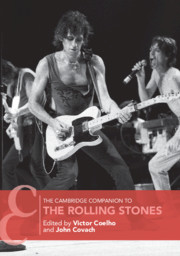Book contents
- The Cambridge Companion to the Rolling Stones
- Cambridge Companions to Music
- The Cambridge Companion to the Rolling Stones
- Copyright page
- Dedication
- Contents
- Illustrations
- Tables
- Notes on Contributors
- Preface
- Abbreviations
- Part I Albums, Songs, Players, and the Core Repertory of the Rolling Stones
- 1 The Rolling Stones: Albums and Singles, 1963–1974
- 2 Guitar Slingers and Hired Guns: The Musicians of the Rolling Stones
- 3 The Rolling Stones in 1968: In Defense of Lingering Psychedelia
- 4 Exile, America, and the Theater of the Rolling Stones, 1968–1972
- 5 Post Exile: The Rolling Stones in a Disco-Punk World, 1975–1983
- Part II Sound, Roots, and Brian Jones
- Part III Stones on Film, Revival, and Fans
- Bibliography
- Index of Songs, Albums, and Visual Media Cited in the Text
- General Index
3 - The Rolling Stones in 1968: In Defense of Lingering Psychedelia
from Part I - Albums, Songs, Players, and the Core Repertory of the Rolling Stones
Published online by Cambridge University Press: 23 August 2019
- The Cambridge Companion to the Rolling Stones
- Cambridge Companions to Music
- The Cambridge Companion to the Rolling Stones
- Copyright page
- Dedication
- Contents
- Illustrations
- Tables
- Notes on Contributors
- Preface
- Abbreviations
- Part I Albums, Songs, Players, and the Core Repertory of the Rolling Stones
- 1 The Rolling Stones: Albums and Singles, 1963–1974
- 2 Guitar Slingers and Hired Guns: The Musicians of the Rolling Stones
- 3 The Rolling Stones in 1968: In Defense of Lingering Psychedelia
- 4 Exile, America, and the Theater of the Rolling Stones, 1968–1972
- 5 Post Exile: The Rolling Stones in a Disco-Punk World, 1975–1983
- Part II Sound, Roots, and Brian Jones
- Part III Stones on Film, Revival, and Fans
- Bibliography
- Index of Songs, Albums, and Visual Media Cited in the Text
- General Index
Summary
Recorded in March of 1968 and released in May, the Rolling Stones’ “Jumpin’ Jack Flash” quickly rose to the top of the charts in the USA and UK. Its driving guitar riff and straight-ahead rock feel seemed to signal to many that the band had emerged from the psychedelic meanderings of late 1967’s Their Satanic Majesties Request, and the release of Beggars Banquet in December 1968 – the album “Jumpin’ Jack” was originally intended for – served to reinforce the idea that the Stones had made a strong return to their musical roots. Brian Jones was reportedly so excited about the track that “as soon as the session finished he contacted a friend, Ronny Money – wife of musician Zoot Money – and told her that ‘the Stones had returned to rock and roll with this thing called “Jumpin’ Jack Flash,” it’s a gas.’”1 Many writers have emphasized the band’s seemingly new sound in 1968. Philippe Margotin and Jean-Michel Guesdon, for instance write that “the music … represents a radical departure from Between the Buttons and Their Satanic Majesties Request,” and Steve Appleford declares that “The Rolling Stones found their moment of absolute clarity in 1968, after a season of drug busts, bad press, and that swirl of forced experimentation called Their Satanic Majesties Request. Confusion was replaced by a new sense of purpose, where passing psychedelic fashion was cast aside in favour of the blues and rock roots that had first inspired them.”2
- Type
- Chapter
- Information
- The Cambridge Companion to the Rolling Stones , pp. 40 - 56Publisher: Cambridge University PressPrint publication year: 2019
- 2
- Cited by



